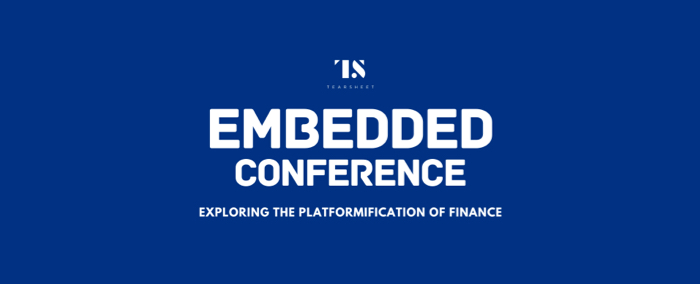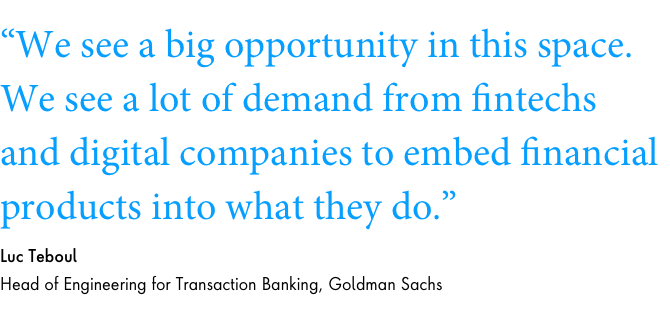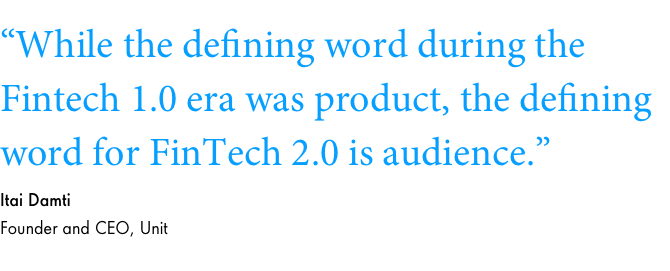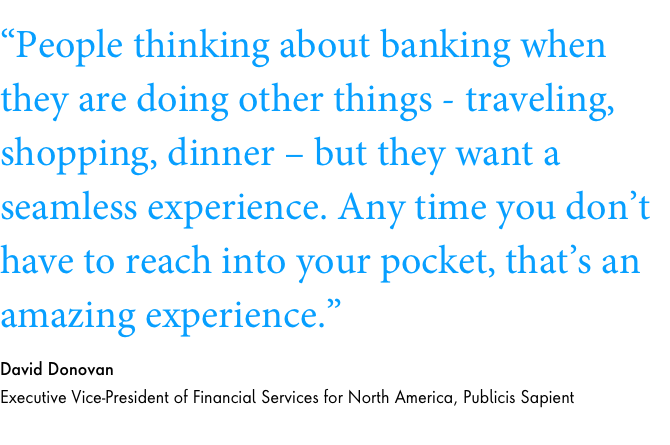What issue can we solve for you?
Type in your prompt above or try one of these suggestions
Suggested Prompt


Insights
Our five big takeaways from Tearsheet’s Embedded Conference 2020
Our five big takeaways from Tearsheet’s Embedded Conference 2020
Finance leaders at Embedded Conference 2020 in November explored the huge market opportunities emerging as financial services are woven into every type of product and service

The nature of banking is changing. Embedded finance is turning every app, retailer and business into a bank. Today’s consumer demands flexibility in how and where they engage with financial services to get what they want. “Banks that take advantage of this shift will outpace their customers and seize a new generation of customers across a multitude of channels. Banks that fail to adapt risk extinction,” said David Donovan, executive vice-president of financial services for North America at Publicis Sapient.
We were proud both to sponsor and speak at Tearsheet’s recent Embedded Conference, where a common thread ran through the sessions: that banking will soon be woven inextricably into consumers’ relationships with the brands they love.
As Donovan emphasized in a recent interview with Tearsheet, embedded finance provides opportunities for banks to integrate with other brands to offer new products and services to their customers.
Here are five key takeaways from the conference.
Takeaway 1
Banks are facing big strategic decisions
Covid-19 has intensified the tough economic conditions that squeeze banks’ profitability, noted David Murphy, managing partner, financial services EMEA and APAC at Publicis Sapient. But it has also accelerated technology shifts – digitization is turning banks into technology companies and their banking services are becoming largely commoditized.
They must respond by speeding up their transformation programs and rethinking distribution channels and the way they engage customers.
This is unfamiliar territory, and many banks are unprepared. How should they respond? The key strategic question is whether to become “financial plumbing”, leveraging their balance sheets but plugging into other marketplaces via tie-ups such as Amazon/Goldman Sachs or Google/Citi, or to “make the market” by expanding into non-traditional services.
This embedded finance model is becoming an integral part of many banks’ plans, driven by their need to revitalize growth by rethinking the way they engage customers.
But to succeed, banks need to be hyper-efficient, utilize customer data much more effectively and be more innovative and flexible in their product development and delivery. This means their senior executives must have an intimate understanding of the platform model and a strong commitment to speed up the transformation.
Takeaway 2
Why Goldman Sachs moved into Banking-as-a-Service
Goldman Sachs is pushing into the Banking-as-a-Service market with its cloud-native transaction banking platform, Luc Teboul, head of engineering for transaction banking, told the Behind the Build session. The platform, which Publicis Sapient helped to create, was originally intended to deliver digital solutions to the bank’s treasury clients. But now Goldman has much bigger plans for it.
Goldman has co-designed the platform with its clients and will integrate it seamlessly into their business. “We have evolved our platform based on the solution that our partners wanted,” said Teboul.
The platform is available in the US currently, but Goldman is working towards launches in Europe and Asia, and over the coming year will expand its capabilities to include a multi-currency offering.

Takeaway 3
Incumbents are finally embracing the future with far-reaching transformational plans
Justin Wee, head of digital banking at Marqeta, explained how the organisation is starting to talk to banks about leveraging expertise on projects beyond its core offering of card issuing and payment solutions.
Buy-now-pay-later, which has grown very quickly during the pandemic, has garnered the most interest, however two other much more transformational initiatives have emerged that will have profound effects in the long term.
One is banks looking to build their own digitally-native challenger banks and the other is organizations looking to transition from their legacy tech stack.
“[This] is the most difficult, said Wee. “How do you modernize your tech stack while ensuring there are no disruptions in your portfolio? You need to figure out how you compartmentalize so you aren’t taking on everything in one fell swoop.”
Takeaway 4
Fintech 2.0 is all about non-financial companies
Over the next decade, thousands of companies will integrate financial services into their products and services, predicted Itai Damti, founder and CEO of Unit. This is the most useful way to understand Fintech 2.0, he explained.
Damti said FinTech 1.0 involved entrants trying to displace financial services incumbents with disruptive products and hoping to find distribution before the incumbents could use their scale to respond. While there were some successes – Acorn, Betterment and Venmo – most did not survive.
Unit addresses the Fintech 2.0 market – its platform enables non-financial companies, mainly in software, to embed financial services into their propositions. Their clients do not need to have a direct relationship with a bank, said Damti, and can instead create this by working with Unit.
However, he also stressed that the bank remains the manufacturer of financial products and their legal owner. In the extended supply chain that Unit enables, the brand provides distribution, but to succeed it must function more like a bank.

Takeaway 5
Seamless user experience is the key to success
Embedded finance is a business opportunity for any brand, regardless of domain, said David Donovan, executive vice-president of financial services for North America at Publicis Sapient. For banks facing muted growth, it’s also a great opportunity to increase revenues from existing clients and win new ones.
Michael Fitzgerald, head of corporate strategy at DriveWealth, said customer experience was the front end and light banking infrastructure the back end. Some banks will want to own the whole supply chain while others will partner with digital leaders and let them control the customer experience.
Those partnerships will include Big Tech players, said Dov Marmor, COO for North America at Railsbank. They are very focused on consumers have millions of relationships. He expected Big Tech companies to acquire apps that have done a great job crafting user experiences and embed them in their ecosystems. “I’m surprised we haven’t seen more of it but it could be price tag.”

For Paul Diegelman, vice-president of digital payments and data aggregation at Fiserv, the collection and sharing of customer data was the biggest opportunity in embedded finance. “There are so many use cases we haven’t thought of yet. How does sharing their financial data make their lives easier?” he said.
Conclusion
Embedded Conference 2020 highlighted the speed of the digital transition that’s under way in banking and payments. Terry Angelos, senior vice-president and global head of fintech at Visa, said the company’s fintech ecosystem was a key growth engine because fintechs were “doing the most to convert cash to digital payment methods”.
And the fintech-driven evolution of banking is still in its opening act. “We are just at the beginning,” said Clay Wilkes, CEO of Galileo. “We may be entering a 20-year phase of innovation in the way we interact with our money.” The key for incumbent banks is to speed up the innovation cycle to generate more insights more quickly. “Having a partner that can provide those services is key to that learning,” he said.






